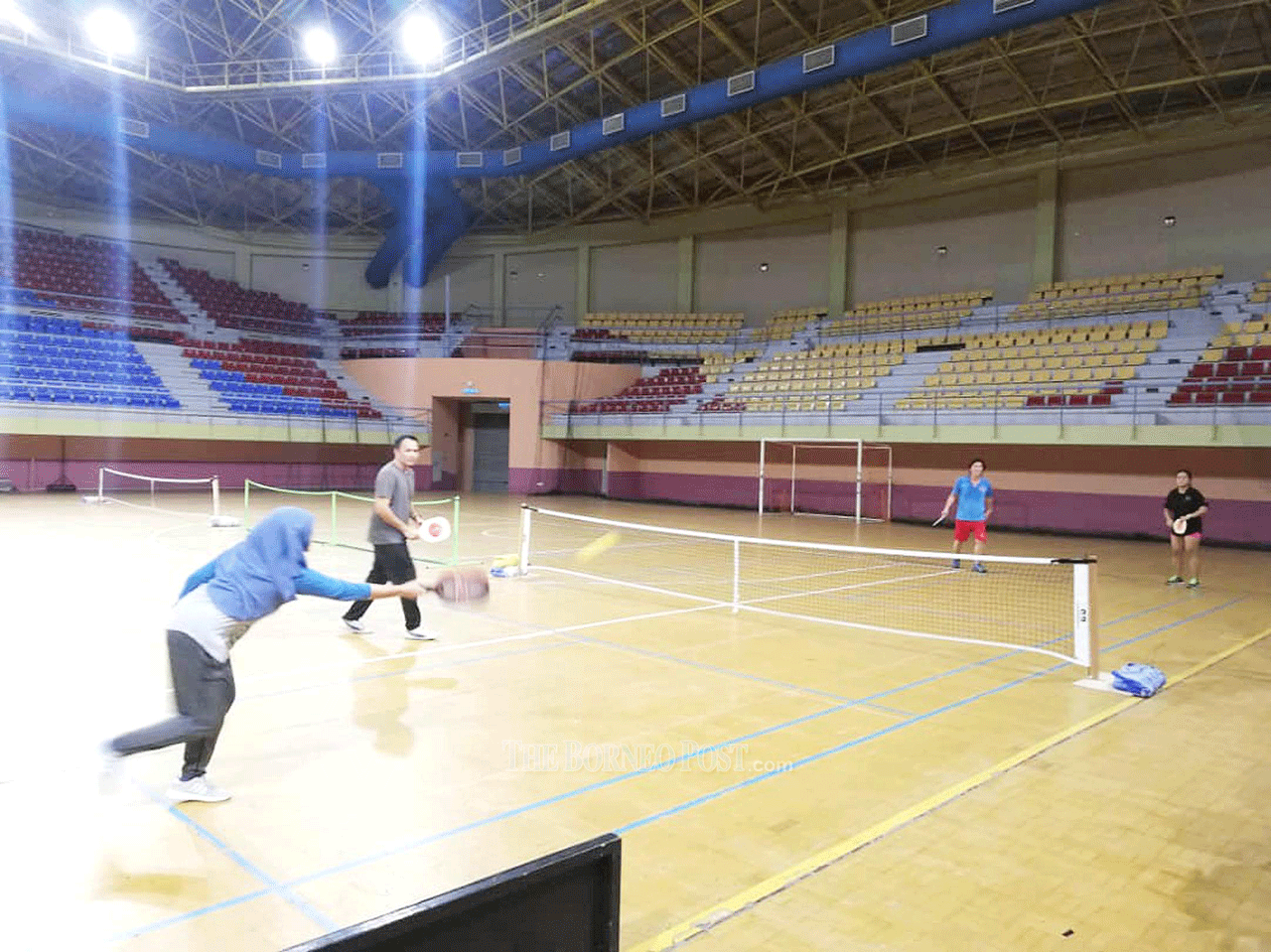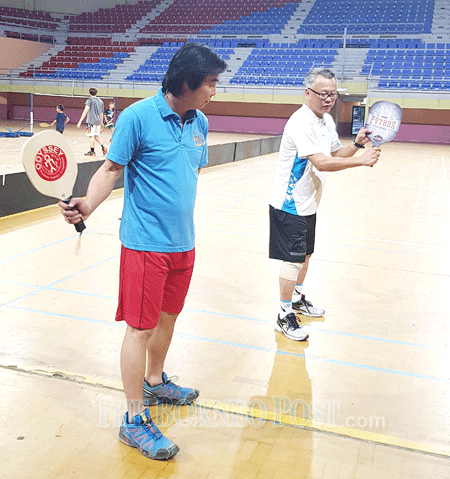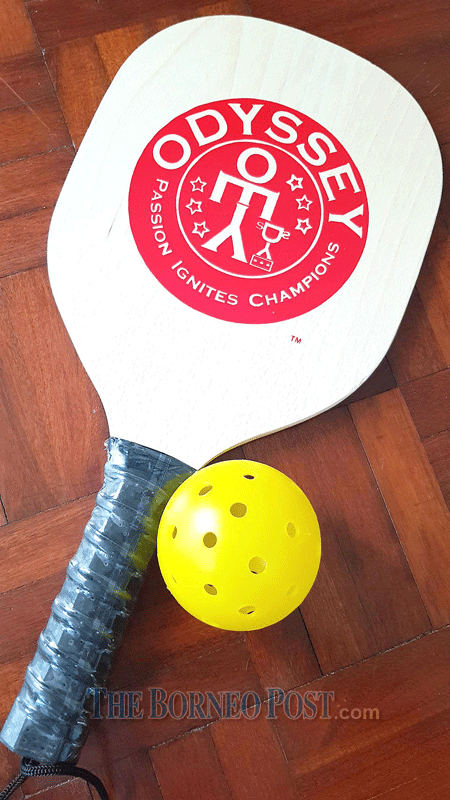
NSJA members play pickleball after learning the basics of the game.
ASK anyone about pickleball and they will probably give you a blank look and tell you to repeat the name.
Yes, it’s pickleball, a sport invented in the 1960s, which is slowly (but surely) catching on with sports enthusiasts in Malaysia.
Pickleball is a combination of badminton, tennis, and table tennis and is something for all ages. This racquet sport was started in the United States. Today, Singapore, Thailand, as well as other neighbouring countries are playing it. In fact, the sport has been included in the Singapore National Games.
College principal Farrell Choo regularly conducts pickleball sessions for his students in Miri as one of their extracurricular activities.
Recently, he and his wife Sally Jong ran a pickleball workshop for the Northern Sarawak Journalists Association (NSJA) at the Miri Indoor Stadium.
Choo said he discovered pickleball through the internet and then did some research on the sport and its origins.
What excites him is that this racquet sport can be played by all ages – from kids to seniors in their 80s.
He introduced the sport to the students and staff and they enjoyed playing it. He also created a Facebook page to promote the sport and connect with pickleball communities around the world, including in the United States, Singapore, Indonesia, and other Asian countries. The information he has gotten from them has been very enlightening.
“I realise pickleball has yet to make a strong presence in Malaysia. That’s where I plan to get the sport going by promoting it to various organisations and schools in Miri,” he told thesundaypost.

Choo (right) shows reporter Lee Cheng Choi the fundamentals of pickleball.
Quite easy
According to Choo, playing pickleball shouldn’t be much of a problem for Malaysians since they are used to badminton, tennis, and table tennis.
The sport is easy to pick up and very exciting to play. After a few games, you should already get the hang of it. Many people take it up to promote good health, but it’s also fast becoming a competitive and professional sport around the world.
“This sport has tremendous potential. It can provide the community with an avenue to pursue an active lifestyle and offer those wishing to take up competitive sports not only the opportunities to get started but also the prospect of representing their teams in local and international tournaments,” he said.
Court and rules
The pickleball court is the same size as a badminton court, while the net is pretty similar to tennis’ – strung across at 36 inches on both ends and 34 inches at the centre.
It can be played outdoors or indoors, with either wooden or composite paddles. There are two formats – doubles and singles – but the former is more popular.
The game is played using a perforated, lightweight, and resilient plastic ball, which can bounce. It’s called a wiffle ball.
The serve must be made underhand where paddle contact with the ball must be below the server’s waist (belly button level). It must also be made diagonally (cross court) and land within the confines of the opposite diagonal court. Both feet must be behind the baseline for the serve (neither foot may touch the baseline or the court area until after the ball is struck).
Only one serve is allowed, except in a ‘let’ (ball touches net and lands in proper court).

A pickleball racket and ball.
The ‘kitchen’
There is a zone called the non-volley zone, also known as the ‘kitchen’ – the court area within seven feet on both sides of the net. Volleying is prohibited within this zone.
This rule prevents players from executing smashes from a position within the zone. It’s a fault if or when volleying a ball, a player steps on the non-volley zone, including the line, and/or when the player’s momentum causes him or her to touch the kitchen zone, including the associated lines.
A player is allowed to enter the kitchen zone any time except when volleying.
A volley is simply a ball hit out of the air that hasn’t bounced and a player cannot hit a volley while standing inside or on the line of the kitchen zone or while moving into the zone.
It’s a fault even if the player hits a volley outside the kitchen zone but the momentum carries him into it.
Both players on the serving doubles team serve and score points until they commit a fault, and at the beginning of each new game, only one partner on the serving team serves before faulting, after which the service passes to the receiving team. Subsequently, as noted above, both players serve.
The first serve of each side-out is made from the right-hand court and if a point is scored, the server switches sides and initiates the next serve from the left-hand court.
As subsequent points are scored, the server continues switching back and forth until a fault is committed and the first server loses the serve.
The second server continues serving until his team commits a fault and loses the serve to the opposing team.
Once the service goes to the opposition (at side out), the first serve is from the right-hand court and both players in that team have the opportunity to serve and score points until their team commits two faults.
Double bounce
According to Choo, there is also a double-bounce rule where when the ball is served, the receiving team must let it bounce before returning. Likewise, the serving team must also let the ball bounce before returning, hence two bounces or the double-bounce rule.
After the ball has bounced once in each team’s court, both teams may either volley the ball or play it off a bounce. The double-bounce rule eliminates the serve-and-volley advantage and extends rallies.
Points are scored only by the serving team and games can be played to 11, 15 or 21 points, winning by two.
The server calls the score before serving. The score is called out as three numbers – serving team score, receiving team score, and server number (one or two).
To start a match, the score is called out as ‘zero-zero-two’ (note on the initial serve, only one member of the serving team serves).
At the beginning of the game, the player on the right side of the court serves and if a point is scored, the server moves to the left side of the court and serves again.
The serving team continues alternating as points are scored. The receiving team does not alternate sides.
“It’s a very easy game once you get the hang of it. We hope it’ll grow and catch on fast in Miri and other parts of Malaysia. We would like to see more organisations and schools take up pickleball,” Choo said.
